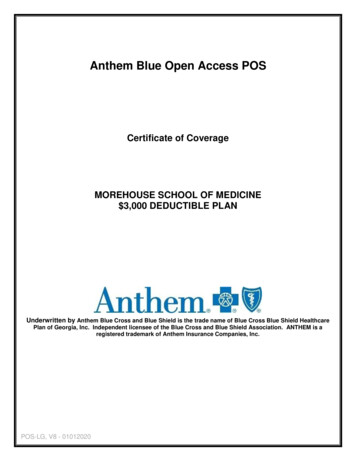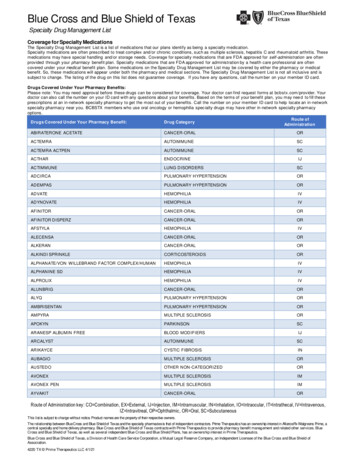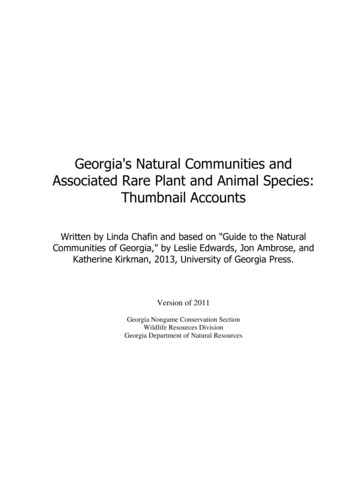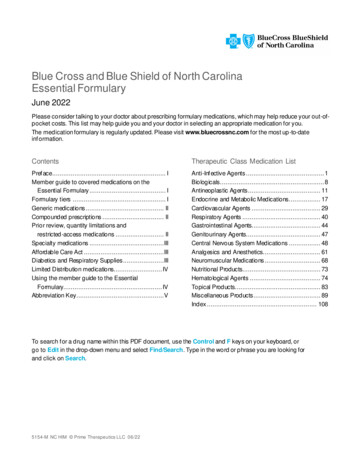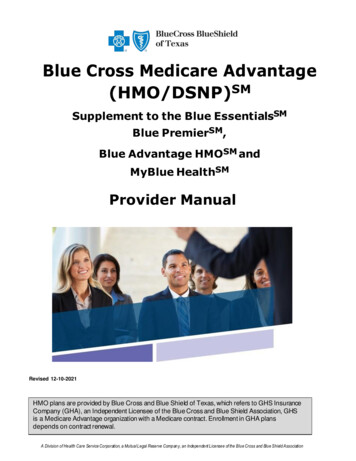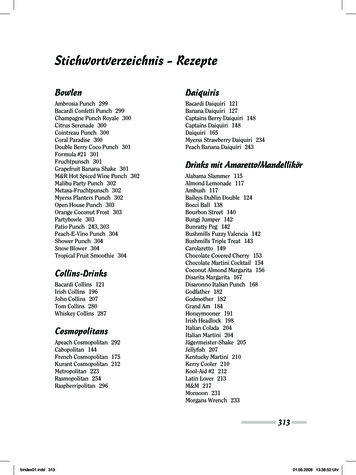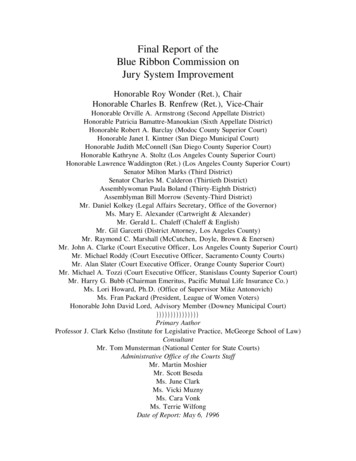
Transcription
Final Report of theBlue Ribbon Commission onJury System ImprovementHonorable Roy Wonder (Ret.), ChairHonorable Charles B. Renfrew (Ret.), Vice-ChairHonorable Orville A. Armstrong (Second Appellate District)Honorable Patricia Bamattre-Manoukian (Sixth Appellate District)Honorable Robert A. Barclay (Modoc County Superior Court)Honorable Janet I. Kintner (San Diego Municipal Court)Honorable Judith McConnell (San Diego County Superior Court)Honorable Kathryne A. Stoltz (Los Angeles County Superior Court)Honorable Lawrence Waddington (Ret.) (Los Angeles County Superior Court)Senator Milton Marks (Third District)Senator Charles M. Calderon (Thirtieth District)Assemblywoman Paula Boland (Thirty-Eighth District)Assemblyman Bill Morrow (Seventy-Third District)Mr. Daniel Kolkey (Legal Affairs Secretary, Office of the Governor)Ms. Mary E. Alexander (Cartwright & Alexander)Mr. Gerald L. Chaleff (Chaleff & English)Mr. Gil Garcetti (District Attorney, Los Angeles County)Mr. Raymond C. Marshall (McCutchen, Doyle, Brown & Enersen)Mr. John A. Clarke (Court Executive Officer, Los Angeles County Superior Court)Mr. Michael Roddy (Court Executive Officer, Sacramento County Courts)Mr. Alan Slater (Court Executive Officer, Orange County Superior Court)Mr. Michael A. Tozzi (Court Executive Officer, Stanislaus County Superior Court)Mr. Harry G. Bubb (Chairman Emeritus, Pacific Mutual Life Insurance Co.)Ms. Lori Howard, Ph.D. (Office of Supervisor Mike Antonovich)Ms. Fran Packard (President, League of Women Voters)Honorable John David Lord, Advisory Member (Downey Municipal Court))))))))))))))))Primary AuthorProfessor J. Clark Kelso (Institute for Legislative Practice, McGeorge School of Law)ConsultantMr. Tom Munsterman (National Center for State Courts)Administrative Office of the Courts StaffMr. Martin MoshierMr. Scott BesedaMs. June ClarkMs. Vicki MuznyMs. Cara VonkMs. Terrie WilfongDate of Report: May 6, 1996
Blue Ribbon Commission on Jury System ImprovementTable of ContentsTable of ContentsAcknowledgments . . . . . . . . . . . . . . . . . . . . . . . . . . . . . . . . . . . . . . . . . . . iiiI. Executive Summary . . . . . . . . . . . . . . . . . . . . . . . . . . . . . . . . . . . . . . . . .A. Introduction to the Blue Ribbon Commission . . . . . . . . . . . . . . . . . . . . . .B. Summary of Recommendations . . . . . . . . . . . . . . . . . . . . . . . . . . . . . . .1. Statement of Support for Commission Recommendations . . . . . . . . . . . .2. Implementation of Recommendations and Continuing Oversight . . . . . . .3. The Jury Pool, Juror Treatment and Jury Management . . . . . . . . . . . . .4. Jury Selection and Structure of the Trial Jury . . . . . . . . . . . . . . . . . . .5. The Jury’s Deliberative Function . . . . . . . . . . . . . . . . . . . . . . . . . . .11233379II. The Commission’s Charge and Implementation of Recommendations . . . . . . . .A. The Jury System in Crisis . . . . . . . . . . . . . . . . . . . . . . . . . . . . . . . . .B. Previous Reports on the California Jury System . . . . . . . . . . . . . . . . . . .C. The Commission’s Charge . . . . . . . . . . . . . . . . . . . . . . . . . . . . . . . . .D. Implementation of the Commission’s Recommendations . . . . . . . . . . . . . .1212131516III. The Jury Pool, Juror Treatment and Jury Management . . . . . . . . . . . . . . . . .A. The Jury Pool . . . . . . . . . . . . . . . . . . . . . . . . . . . . . . . . . . . . . . . . .1. Source Lists . . . . . . . . . . . . . . . . . . . . . . . . . . . . . . . . . . . . . . . .2. Summons Stage . . . . . . . . . . . . . . . . . . . . . . . . . . . . . . . . . . . . .3. Hardship Exclusions . . . . . . . . . . . . . . . . . . . . . . . . . . . . . . . . . .B. Juror Treatment . . . . . . . . . . . . . . . . . . . . . . . . . . . . . . . . . . . . . . . .1. Treatment by Court Staff, Attorneys and Judges . . . . . . . . . . . . . . . .2. Transportation and Parking . . . . . . . . . . . . . . . . . . . . . . . . . . . . . .3. Juror Facilities . . . . . . . . . . . . . . . . . . . . . . . . . . . . . . . . . . . . . .4. Privacy . . . . . . . . . . . . . . . . . . . . . . . . . . . . . . . . . . . . . . . . . . .5. Term of Service and Period of Repose . . . . . . . . . . . . . . . . . . . . . . .6. Juror Fees . . . . . . . . . . . . . . . . . . . . . . . . . . . . . . . . . . . . . . . . .C. Jury Management . . . . . . . . . . . . . . . . . . . . . . . . . . . . . . . . . . . . . .18181921252728303133384147IV. Jury Selection and Structure of the Trial Jury . . . . . . . . . . . . . . . . . . . . . . .A. The Juror Selection Process . . . . . . . . . . . . . . . . . . . . . . . . . . . . . . . .1. The Need for Representative Jury Panels . . . . . . . . . . . . . . . . . . . . .2. Improvements to Voir Dire . . . . . . . . . . . . . . . . . . . . . . . . . . . . . .3. Peremptory Challenges . . . . . . . . . . . . . . . . . . . . . . . . . . . . . . . .4950505155i
Blue Ribbon Commission on Jury System ImprovementTable of Contentsa. The Debate Over and Need for Peremptory Challenges . . . . . . . . .b. Reducing the Number of Peremptory Challenges . . . . . . . . . . . . . .B. Structure of the Trial Jury . . . . . . . . . . . . . . . . . . . . . . . . . . . . . . . . .1. The Size of the Trial Jury . . . . . . . . . . . . . . . . . . . . . . . . . . . . . . .2. The Unanimity Requirement . . . . . . . . . . . . . . . . . . . . . . . . . . . . .a. The Debate Over and Need for Unanimity . . . . . . . . . . . . . . . . . .b. Addressing the Problem of Hung Juries andThe Recalcitrant Juror . . . . . . . . . . . . . . . . . . . . . . . . . . . . . . .55596464707075V. The Jury’s Deliberative Function . . . . . . . . . . . . . . . . . . . . . . . . . . . . . . . 80A. Juror Orientation Programs . . . . . . . . . . . . . . . . . . . . . . . . . . . . . . . . 82B. Note-Taking by Jurors . . . . . . . . . . . . . . . . . . . . . . . . . . . . . . . . . . . 83C. Questioning of Witnesses by Jurors . . . . . . . . . . . . . . . . . . . . . . . . . . . 85D. Pre-Deliberation Discussions . . . . . . . . . . . . . . . . . . . . . . . . . . . . . . . 89E. Simplification of Jury Instructions . . . . . . . . . . . . . . . . . . . . . . . . . . . . 91F. The Use of Alternative Jurors . . . . . . . . . . . . . . . . . . . . . . . . . . . . . . . 99G. Trial Management Standards . . . . . . . . . . . . . . . . . . . . . . . . . . . . . . 100Appendix A. Proposed Amendments to the California Constitution . . . . . . . . . . . . . . 103Appendix B. Proposed Amendments to the Codes . . . . . . . . . . . . . . . . . . . . . . . . . . . . 105Appendix C. Proposed Amendments to the Rules of Court . . . . . . . . . . . . . . . . . . . . . 117Appendix D. Proposed Amendments to the Standards of Judicial Administration . . . 123Appendix E. ABA’s Standards Relating to Juror Use and Management . . . . . . . . . . . 129Appendix F. State Bar Principles Relating to Jury Reform . . . . . . . . . . . . . . . . . . . . . 139Appendix G. Jury Facilities Industry Standards . . . . . . . . . . . . . . . . . . . . . . . . . . . . . . 142Appendix H. Juror Fees by State . . . . . . . . . . . . . . . . . . . . . . . . . . . . . . . . . . . . . . . . . 150Appendix I. Estimated Costs of Increased Jury Fees . . . . . . . . . . . . . . . . . . . . . . . . . . 152Appendix J. Voir Dire Questionnaire . . . . . . . . . . . . . . . . . . . . . . . . . . . . . . . . . . . . . . 154Appendix K. Number of Peremptory Challenges by State . . . . . . . . . . . . . . . . . . . . . . 155Appendix L. Probability of Finding Persons on a 12-Person Jury WhoShare a Characteristic . . . . . . . . . . . . . . . . . . . . . . . . . . . . . . . . . . . . . . . . . . . . . . . . 157Appendix M. Jury Size and Verdict Rules by State . . . . . . . . . . . . . . . . . . . . . . . . . . . 158Appendix N. Misdemeanors Where Punishment Is 6 Months or Less . . . . . . . . . . . . . 160Appendix O. Suggested Instruction for Jury Deliberation Procedures . . . . . . . . . . . . . 176Appendix P. Minority Report . . . . . . . . . . . . . . . . . . . . . . . . . . . . . . . . . . . . . . . . . . . . 179ii
Blue Ribbon Commission on Jury System ImprovementAcknowledgmentsAcknowledgmentsA project of this size relies upon contributions from many sources. Inaddition to the strong staff support from the Administrative Office of the Courts,the Commission would like to acknowledge the significant assistance of thefollowing persons to the Commission’s final work product: Ms. Gloria Gomez(Jury Commissioner for the County of Los Angeles); Ms. Janet B. Miller (JuryCommissioner for the County of Sacramento); Ms. Mary Kennedy (Counsel,Senate Criminal Procedure Committee); Mr. David Shaw (Chief Counsel,Assembly Committee on Public Safety); Ms. Pilar Onate (Legislative Assistant,Senator Calderon’s Office); Mr. David Long (Director, Office of Research,State Bar of California); Ms. Angela Johnson and Ms. Wendy Green (ResearchAssistants to Professor J. Clark Kelso, McGeorge School of Law); and themembers of the Hastings School of Law Public Law Research Institute(Professor David J. Jung, Director; Ms. Catherine Albright, Ms. ElizabethEllen Chilton, Ms. Patricia Henley, and Ms. Margot Hunter).iii
Blue Ribbon Commission on Jury System ImprovementChapter I. Executive SummaryChapter IExecutive SummaryA. Introduction to the Blue Ribbon CommissionThe Judicial Council of California (the “Council”), the policy-makingbody for California’s courts, created this Blue Ribbon Commission (the“Commission”) to conduct a comprehensive evaluation of the jury system and tomake timely recommendations for improvement. The Commission is made upof 26 members and is broadly representative of the diverse groups who regularlywork with the courts and juries. The membership includes judges frommunicipal, superior and appellate courts, court administrators, legislators fromthe Assembly and Senate, a representative from the Governor’s office, a districtattorney, defense counsel, civil practitioners, and public members. The chair ofthe Commission is Judge Roy Wonder (Ret.) of the San Francisco SuperiorCourt, and the vice-chair is Judge Charles B. Renfrew (Ret.) of the UnitedStates District Court for the Northern District of California.The Commission was formed by the Council in December of 1995, andthe State Bar of California and the California Judges Association agreed toparticipate as supporting sponsors. The Commission held its first meetings inJanuary of 1996. The Commission divided its work over three subcommittees:Juror Pool, Treatment and Management, chaired by Mr. Michael Roddy,executive officer of the Superior and Municipal Courts of Sacramento County;Jury Selection and Trial Structure, chaired by Justice Patricia BamattreManoukian of the Court of Appeal for the Sixth Appellate District; and JuryFunctioning, chaired by Judge Judith McConnell of the San Diego CountySuperior Court. These three subcommittees met frequently in February, Marchand April to work through the long list of issues for consideration. Mr. TomMunsterman of the National Center for State Courts, one of the country’sleading authorities on juries, attended all meetings and significantly contributedto the Commission’s discussions. Professor J. Clark Kelso of the University ofthe Pacific’s McGeorge School of Law served as reporter for the Commission’sdeliberations and primary author of this Report.Two full days of public hearings were conducted in March in LosAngeles and San Francisco. The Commission also received written commentsand reports from several interested persons. Quotes from these sources are1
Blue Ribbon Commission on Jury System ImprovementChapter I. Executive Summaryinterspersed throughout this report.A draft of this Report was presented to the full Commission for itsconsideration in late March and again in late April for final approval. TheReport was then submitted to the Council at its May meeting in Chico. Aminority report dissenting in part appears in Appendix P.The Commission commends the Council, the Legislature and theGovernor for cooperatively supporting the Commission’s work. Recognizingthat many of the issues considered by the Commission would involve legislativeaction, Chief Justice Malcolm M. Lucas, chairperson of the Council, invited theparticipation of the chairs of the Assembly and Senate Judiciary Committees, theAssembly Public Safety Committee, the Senate Criminal Procedure Committee,and a representative from the Governor’s office. Their participation hasenriched the Commission’s deliberations and has helped to ensure that theCommission’s conclusions will receive full consideration in the legislativeprocess.B. Summary of RecommendationsThe Commission considered hundreds of suggestions in crafting itsrecommendations. Some of the recommendations will command near universalassent. Others are going to create discomfort among one or more groups.Those who are involved with the jury system—jurors, judges, jurycommissioners, attorneys, and California businesses—will be asked to makeindividual sacrifices that will redound to the benefit of all. The Commission’sintent is to push for those changes that are necessary to preserve and improvethe system.Recommendation 1.1: In view of the fundamental importanceof the jury system to public respect for the rule of law, theJudicial Council, the Legislature, the Governor, and the StateBar should seriously consider and support changesrecommended by this Commission that are necessary topreserve, promote and improve the jury system.444444444444444444442
Blue Ribbon Commission on Jury System ImprovementChapter I. Executive SummaryThe Commission attempted in its deliberations to reach consensus on allissues. In many cases, a consensus was possible. On some issues (e.g., jurysize, the number of peremptory challenges, and the requirement of unanimity),consensus was not possible. In these cases, the Commission adoptedrecommendations by majority vote (usually conducted by a show of hands ofthose present). This report clearly identifies those issues where consensus wasnot achieved, presents both the majority and minority arguments, and indicatesthe results of the votes taken by the Commission.The specific recommendations adopted by the Commission are asfollows:1. Support for Commission RecommendationsRecommendation 1.1: In view of the fundamental importance of the jury systemto public respect for the rule of law, the Judicial Council, the Legislature, theGovernor, and the State Bar should seriously consider and support changesrecommended by this Commission that are necessary to preserve, promote andimprove the jury system.2. Implementation of Recommendations and Continuing OversightRecommendation 2.1: The Judicial Council should create an ImplementationTask Force on Jury System Improvements which would be responsible foroverseeing implementation of the Commission’s recommendations. Like themembership of the Commission, the Task Force’s membership should bebroadly representative of the diverse perspectives about the jury system.3. The Jury Pool, Jury Treatment and Jury ManagementRecommendation 3.1: The Judicial Council should adopt a Standard of JudicialAdministration recommending use of the National Change of Address system toupdate jury source lists.Recommendation 3.2: The Implementation Task Force should evaluate theresults of an existing New York program to supplement its jury source lists with3
Blue Ribbon Commission on Jury System ImprovementChapter I. Executive Summarywelfare and unemployment lists and should then consider whether one or moreCalifornia counties should conduct a pilot project supplementing the DMV andregistered voters lists with other comprehensive lists of persons living inCalifornia.Recommendation 3.3: The Judicial Council's Advisory Committee on CourtTechnology, in consultation with the Implementation Task Force, should reviewthe cost, feasibility and efficacy of a statewide master jury list.Recommendation 3.4: The Legislature should enact a statute clearly stating thatjury service is a mandatory duty of all qualified citizens.Recommendation 3.5: The Legislature should amend C.C.P. § 209 and VehicleCode § 12805 to provide mandatory procedures for enforcing juror summons,including placing a hold upon driver’s license renewals of those persons whofail to respond to a juror summons.Recommendation 3.6: The Implementation Task Force should produce a formatfor a standardized jury summons for use, with appropriate modifications, aroundthe State which is understandable and has consumer appeal.Recommendation 3.7: Jury commissioners should, if feasible, adopt a one-stepsummons process (i.e., combined juror questionnaire and summons) to replacethe two-step process (i.e., juror questionnaire followed by summons).Recommendation 3.8: Jury commissioners and judges should actively promotethe importance of the jury system and the duty to serve through all availablechannels of communication.Recommendation 3.9: The Judicial Council should enact a Rule of Court torequire jury commissioners to apply the standards regarding hardship excusespresently set forth in Section 4.5 of the Standards of Judicial Administration.Recommendation 3.10: The Legislature should enact a child-care program forthose jurors who must make special child-care arrangements as a result of juryservice.Recommendation 3.11: The Judicial Council should adopt a Rule of Courtproviding for mandatory judicial, court administrator, and jury staff teamtraining on juror treatment.4
Blue Ribbon Commission on Jury System ImprovementChapter I. Executive SummaryRecommendation 3.12: The Judicial Council should adopt a Rule of Courtrequiring jury commissioners to prepare a juror handbook which sets forth thejuror’s rights and responsibilities and explains juror services within thecourthouse.Recommendation 3.13: The Judicial Council should adopt a Rule of Courtrequiring the creation within each court of some reasonable mechanism forresponding to juror complaints.Recommendation 3.14: To reduce the burden of long-distance driving and toreduce parking problems, the Legislature should consider the propriety ofmeasures requiring mass transit providers to offer free public transportation toand from courthouses for jurors.Recommendation 3.15: The Legislature should amend C.C.P. § 215 to requirecourts to reimburse jurors for all reasonable and necessary parking expenses orto provide free parking consistent with local building and transportationpolicies.Recommendation 3.16: Trial courts should review existing jury facilities in lightof national standards and, at a minimum, should take whatever steps arenecessary to bring all jury facilities up to those standards.Recommendation 3.17: The presiding judge of the court should ensure that jurorsecurity within the courthouse and from juror parking facilities to the courthouseis properly coordinated and supervised by the court security officer.Recommendation 3.18 (by a vote of 16 to 2): The Legislature should enactlegislation providing that jurors will be identified throughout the jury selectionprocess only by number and not by name, and that personal juror identifyinginformation shall not be elicited during voir dire except on a showing of acompelling need.Recommendation 3.19: The Legislature should enact a statute giving jurors theright to respond in chambers to questions during voir dire that elicit highlypersonal information and requiring that the court inform jurors of this right.Recommendation 3.20: The Legislature should amend C.C.P. § 237 to ensurethat personal juror identifying information is properly safeguarded in the contextof post-verdict proceedings.5
Blue Ribbon Commission on Jury System ImprovementChapter I. Executive SummaryRecommendation 3.21: The Judicial Council should adopt a Rule of Courtrequiring by January 1998 adoption of a one trial - one day service requirementexcept in those counties which can demonstrate good cause why such arequirement is impractical.Recommendation 3.22: The Judicial Council should adopt a Rule of Courtrequiring by January 1998 implementation of an “on-call” telephone stand-bysystem in every county except in those counties which can demonstrate goodcause why such a system is impractical.Recommendation 3.23: Presiding judges should discuss the topic of casepredictability and late settlements with participants in the criminal justice systemin meetings required by Rule of Court 227.8.Recommendation 3.24: The Legislature should amend C.C.P. § 204 to providethat an eligible person shall be excused from service for a minimum of twelvemonths if he or she has completed jury service.Recommendation 3.25: The Legislature should amend C.C.P. § 215 to providefor juror fees of 40 per day for each day of jury service after the first day and 50 per day for each day of jury service after the thirtieth day, and to providefor reimbursement to jurors at the rate of 0.28 per mile for travel to and fromthe court.Recommendation 3.26: The Legislature should amend Section 230 of the LaborCode to require all employers to continue paying usual compensation andbenefits to employees for the first three days of jury service if the employee hasgiven reasonable notice to the employer of the service requirement.Recommendation 3.27: The Legislature should adopt reasonable tax credits forthose employers who voluntarily continue paying usual compensation andbenefits to employees who are absent from work for more than three days onaccount of jury service.Recommendation 3.28: The Legislature should amend the UnemploymentInsurance Code to provide that, except for the first day, jury service constitutesan employment disability which entitles the employee to a claim in the amountof 40 per day (increased to 50 per day after the 30th day of service).Recommendation 3.29: The Trial Court Presiding Judges Advisory Committee6
Blue Ribbon Commission on Jury System ImprovementChapter I. Executive Summaryand Court Administrators Advisory Committee should systematically monitorand study critical components of the jury system for the purpose of permittingmore informed policy-making and management.4. Jury Selection and Structure of the Trial JuryRecommendation 4.1: The Judicial Council should amend Section 8.8 of theStandards of Judicial Administration to encourage the Center for JudicialEducation and Research (“CJER”) to produce educational materials andprograms focused on the conduct of voir dire, particularly in criminal cases, thatcan be distributed to all judges for use and review.Recommendation 4.2: The Judicial Council should amend Section 8.7 of theStandards of Judicial Administration to include a list of factors judges shouldconsider when making the “good cause” determination under C.C.P. § 223.Recommendation 4.3: Rules of Court 228.2 & 516.2, which give the trial courtdiscretion to determine the appropriate method of supplementing the court’s voirdire, should not be changed.Recommendation 4.4: The Judicial Council should adopt a Standard of JudicialAdministration encouraging the use of a statewide juror questionnaire to bedeveloped by the Implementation Task Force to gather basic juror information,other than juror identification information, for use by the court and counsel invoir dire.Recommendation 4.5: A reasonable and equal number of peremptory challengesmust be given to each side in criminal and civil cases, and the trial court shouldbe given discretion to increase the number of peremptory challenges for goodcause in the interests of justice.Recommendation 4.6 (by a series of majority votes): The Legislature shouldamend C.C.P. § 231 to provide each side with 12 peremptory challenges incases where the offense charged is punishable with death or with lifeimprisonment, 6 peremptory challenges in all other felonies, and 3 peremptorychallenges in all misdemeanors. (The votes are reported below in the text.)Recommendation 4.7: There should be a proportional reduction in the number7
Blue Ribbon Commission on Jury System ImprovementChapter I. Executive Summaryof additional peremptory challenges given for multi-defendant cases.Recommendation 4.8 (by a series of votes): The Legislature should amendC.C.P. § 231(c) to provide each party in a 2-party civil action with 3peremptory challenges, and each side in all other civil actions with 6 peremptorychallenges. (The votes are reported below in the text.)Recommendation 4.9: In capital cases and felonies, the jury should consist of 12persons.Recommendation 4.10 (by a vote of 14 to 7): The Legislature should propose anamendment to the California Constitution, Article I, § 16, to provide for a juryof 8 persons in all misdemeanor cases or a lesser number agreed on by theparties.Recommendation 4.11 (by a vote of 19 to 2): The Legislature should eliminatejuries from those misdemeanors that do not carry any possible jail time.Recommendation 4.12 (by a vote of 13 to 5): In civil cases within thejurisdiction of the superior court, the jury should consist of 12 persons or alesser number agreed on by the parties.Recommendation 4.13 (by a vote of 15 to 6): The Legislature should amendC.C.P. § 220 to provide that in civil cases within the jurisdiction of themunicipal court, the jury should consist of 8 persons or a lesser number agreedon by the parties.Recommendation 4.14: The Commission recommends that the Judicial Councilconduct a short (e.g., 4-6 month), focused study to gather more reliableinformation regarding: (1) the percentage of hung juries and the vote split; (2)the reasons why individual juries are unable to reach a verdict (data that couldbe collected from a form to be filled out by the jury foreperson); and (3) thesubsequent history of cases resulting in hung juries (e.g., number of casesretried with the results, number of cases pled, number of cases dropped). Datacan be collected from court records and from files within the offices of countyprosecutors and public defenders.Recommendation 4.15: A unanimous verdict should continue to be required forcriminal cases in which the punishment is death or life imprisonment.8
Blue Ribbon Commission on Jury System ImprovementChapter I. Executive SummaryRecommendation 4.16 (by a vote of 13 to 4): If the jury size in misdemeanorcases is reduced from 12 to 8 (as provided for in Recommendation 4.10), thenunanimous verdicts should be required.Recommendation 4.17 (by a vote of 20 to 1): After a jury reports it isdeadlocked, the trial judge should reemphasize to the jury the importance ofarriving at a verdict and each juror’s duty to deliberate. The trial judge shouldalso explain that the foreperson should report to the judge if any juror isrefusing to participate in deliberations or has a bias not disclosed in voir dire.Recommendation 4.18 (by a vote of 15 to 7): The Legislature should propose aconstitutional amendment which provides that, except for good cause when theinterests of justice require a unanimous verdict, trial judges shall accept an 11-1verdict after the jury has deliberated for a reasonable period of time not lessthan 6 hours in all felonies, except where the punishment may be death or lifeimprisonment, and in all misdemeanors where the jury consists of 12 persons.5. The Jury’s Deliberative FunctionRecommendation 5.1: The Implementation Task Force should produce aprofessional quality, statewide juror orientation videotape which can be used byjury commissioners, with or without modification, to satisfy the statutoryobligation to provide juror orientation.Recommendation 5.2: The Judicial Council should adopt a Rule of Court whichrequires the trial court to inform jurors of their right to take written notes andwhich gives the trial judge discretion to determine the post-verdict disposition ofjuror notes.Recommendation 5.3: The Judicial Council should adopt a Standard of JudicialAdministration recommending that judges permit jurors to submit writtenquestions to the court which, subject to the discretion of the trial judge and therules of evidence, may be asked of witnesses who are still on the stand. TheStandard should include a pre-trial admonition explaining the procedure tojurors.Recommendation 5.4: The Judicial Council should reconsider in January 19989
Blue Ribbon Commission on Jury System ImprovementChapter I. Executive Summarythe issue of pre-deliberation discussions by jurors based on a review of theexperience in Arizona. In the meantime, the Council should adopt a Standard ofJudicial Administration that encourages trial judges to experiment in long civiltrials with scheduled pre-deliberation discussions upon stipulation of counselwith appropriate admonitions regarding withholding judgment until deliberationshave begun.Recommendation 5.5: The Judicial Council should oppose legislation that wouldpermit or require trial judges to inform the jury of its power of nullification.Recommendation 5.6: The Judicial Council should adopt a Standard of JudicialAdministration recommending that trial judges, in their discretion, pre-instructthe jury on the substantive law of issues involved in the case.Recommendation 5.7: The Judicial Council should adopt a Standard of JudicialAdministration that encourages counsel in cases involving highly complexsubject matters jointly to develop a glossary of common terms which can bedistributed to each juror at the beginning of trial.Recommendation 5.8: The Judicial Council should appoint a Task Force on JuryInstructions to be charged with the responsibility of drafting jury instructionsthat accurately state the law using language that will be understandable to jurors.Proposed instructions should be submitted to the Judicial Council and theCalifornia Supreme Court for approval. The membership of the Task Force onJury Instructions should be diverse, including judges, lawyers, representativesfrom the Committee on Standard Jury Instructions of the Superior Court of LosAngeles, linguists, commu
Blue Ribbon Commission on Jury System Improvement Honorable Roy Wonder (Ret.), Chair Honorable Charles B. Renfrew (Ret.), Vice-Chair Honorable Orville A. Armstrong (Second Appellate District) Honorable Patricia Bamattre-Manoukian (Sixth Appellate District) Honorable Robert A. Barclay (Modoc County Superior Court)




